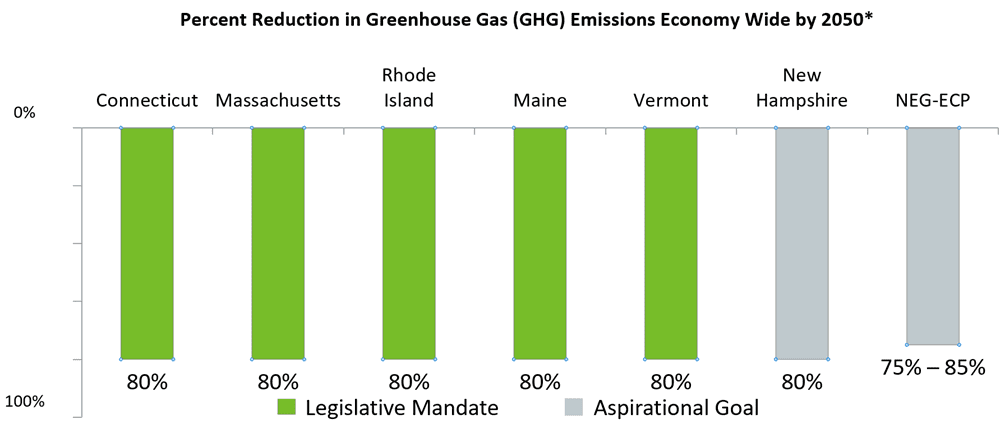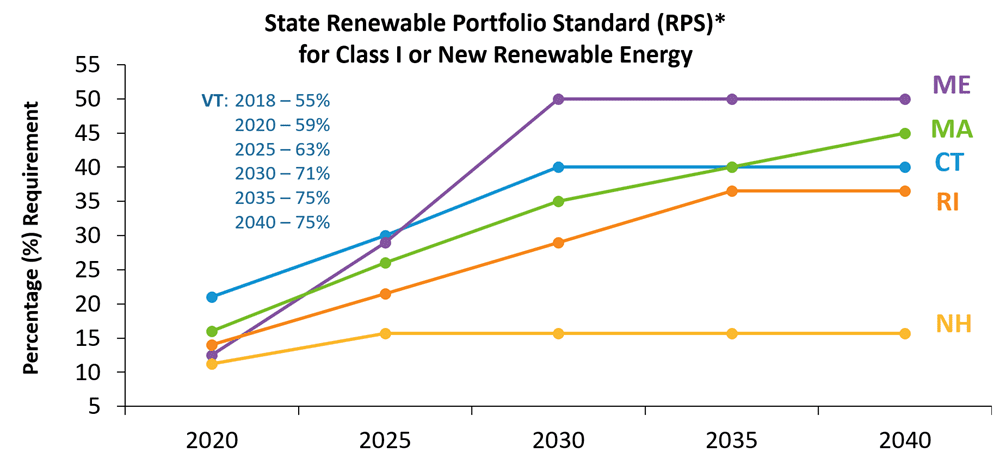The New England states’ frameworks for reducing greenhouse gas emissions continue to evolve

ISO New England’s External Affairs team tracks energy policy initiatives in the states, and posts periodic updates on ISO Newswire. Here’s an update on state goals in the region, including some recent developments.
Southern New England states sign memorandum of understanding on Transportation Climate Initiative Program
In December 2020, three New England states—Massachusetts, Connecticut, and Rhode Island—signed a memorandum of understanding committing to establish a multijurisdictional program, known as the Transportation and Climate Initiative Program, to reduce carbon dioxide (CO2) emissions from the transportation sector, among other goals. The states are targeting at least a 26 percent reduction in CO2 emissions from transportation between 2023 and 2032.
New England states release energy vision
In October 2020, the New England states released a statement, through the New England States Committee on Electricity (NESCOE), outlining their vision for a clean, affordable, and reliable 21st century regional electric grid. The vision statement covers three main areas: market design, transmission planning, and ISO governance. As part of the effort, the states announced a series of online technical forums for early 2021 to discuss the three focus areas. Information on the vision statement and technical forums is available on the initiative’s website: New England Energy Vision. The states intend to report to their respective governors in the first quarter of 2021 on findings and recommendations for action steps to advance this vision.
New England states continue to advance policies to reduce greenhouse gas emissions
Since 2001, the six New England states have been working to reduce greenhouse gas (GHG) emissions. Through regional agreements as well as state legislative mandates and aspirational goals, the New England states are moving toward economy-wide GHG reductions.
State GHG reduction mandates
- Maine: Passed an Act To Promote Clean Energy Jobs and To Establish the Maine Climate Council in 2019 that requires the state to reduce GHG emissions to 45 percent below 1990 levels by 2030 and 80 percent by 2050.
- Connecticut: Passed an Act Concerning Connecticut Global Warming Solutions in 2008 that requires the state to reduce its GHG emissions to 80 percent below 2001 levels by 2050. In 2018, the state established an interim benchmark for GHG emissions reductions of 45 percent below 2001 levels in 2030.
- Rhode Island: Passed the Resilient Rhode Island Act in 2014 that requires the state to reduce GHG emissions to 80 percent below 1990 levels by 2050.
- Massachusetts: Passed the Global Warming Solutions Act in 2008 that requires the state to reduce GHG emissions to 80 percent below 1990 levels by 2050. In 2020, using the authority under the Global Warming Solutions Act, the Massachusetts Executive Office of Energy and Environmental Affairs issued a letter of determination setting a net zero emissions limit by 2050.
- Vermont: Passed an Act Relating to Addressing Climate Change in 2020 that requires the state to reduce GHG emissions to 26 percent below 2005 levels by 2025, 40 percent below 1990 levels by 2030, and 80 percent below 1990 levels by 2050.
State GHG Reduction Aspirational Goals
- New Hampshire: Published the New Hampshire Climate Action Plan in 2009, which calls for an 80 percent reduction in GHG emissions below 1990 levels by 2050.
New England states support regional and inter-regional GHG reduction Initiatives
The New England Governors and Eastern Canadian Premiers (NEG-ECP) are pursuing nonbinding GHG reduction goals adopted in August of 2001. In 2017, NEG-ECP released the 2017 Update of the Regional Climate Change Action Plan, originally issued in 2001, chronicling the progress in meeting GHG reduction goals:
- Goal: Reduce GHG emissions to 1990 levels by 2010; Progress: the states indicate that the goal has been met
- Goal: Reduce emissions by 10% below 1990 levels by 2020; Progress: as of the 2017 report, the states are on target to meet the goal
- Goal: Reduce emissions to at least 35% to 45% below 1990 levels by 2030
- Goal: Reduce emissions by 75% to 85% below 2001 levels by 2050
In August 2018, the governors and premiers highlighted their efforts to reduce GHG emissions in a resolution concerning energy security and affordability that, among other things, encouraged policies that “diversify resources and target affordable clean energy deployment” (Resolution 42-2).
Additionally, five of the six New England governors signed the 2015 nonbinding memorandum of understanding, entitled Under 2 MOU, which seeks to limit global warming to below two degrees (2°) Celsius. As signatories, Connecticut, Massachusetts, Rhode Island, Vermont, and New Hampshire supported reducing GHG emissions to 80 percent to 95 percent below 1990 levels by 2050.

In addition to their individual state goals and laws, all six New England states have been members of the Regional Greenhouse Gas Initiative (RGGI) since 2007. The first mandatory cap-and-trade program in the United States to limit carbon dioxide (CO2) in the power sector, RGGI is a tool for some of the states to invest—via the revenue-generating auction mechanism of CO2 allowances—in efforts such as energy efficiency and renewable energy.
New England states set Renewable Portfolio Standards and conduct long-term procurements
Adding renewable energy to the mix of power system resources is part of the strategy employed by the states to reduce GHG emissions. In this regard, each New England state requires that, by specific dates, retail electricity sales comprise certain percentages of renewable energy generation. The chart below is a snapshot of state requirements for electricity providers to supply customers with specified amounts of Class I or new renewable power by 2040.

Notes: State RPS requirements promote the development of renewable energy resources by requiring electricity providers (electric distribution companies and competitive suppliers) to serve a minimum percentage of their retail load using renewable energy. Connecticut’s Class I RPS requirement plateaus at 40 percent in 2030. Maine’s Class I/IA RPS requirement increases to 50 percent in 2030 and remains at that level each year thereafter. Massachusetts’ Class I RPS requirement increases by 2 percent each year between 2020 and 2030, reverting back to 1% each year thereafter, with no stated expiration date. New Hampshire’s percentages include the requirements for both Class I and Class II resources (Class II resources are new solar technologies beginning operation after January 1, 2006). New Hampshire’s Class I and Class II RPS requirements plateau at 15.7% in 2025. Rhode Island’s requirement for ‘new’ renewable energy plateaus at 36.5 percent in 2035. Vermont’s ‘total renewable energy’ requirement plateaus at 75 percent in 2032; it recognizes all forms of new and existing renewable energy and is unique in classifying large-scale hydropower as renewable.
Beginning in 2015, several New England states began issuing requests for proposals (RFPs) to procure renewable and other clean energy resources to also help achieve their emissions reductions [and other policy] goals. Through these procurement efforts, which range from 20 MW to 2,000 MW, the states seek long-term contracts for the development (or retention) of more than 7,000 MW of clean energy resources. The states are targeting most of the resources to be on line in the 2020 to 2024 timeframe and if the current RFPs and approved contracts come to fruition, they will account for a significant portion of the regional electric load.
- Categories
- Inside ISO New England
- Tags
- new england states, renewable resources
